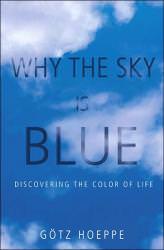Just a few pages into Gotz Hoeppe’s book, Why the Sky is Blue – Discovering the Color of Life and I was staring into the daytime sky. Sure we all know it’s blue, and most of us know why. Or, at least we think we know why. This book shows that our sky comes in as many shades of blue as a painter has in their palette. But each shade has an natural explanation, hence the size and value of this enlightening book.
Hoeppe’s book works through humanity’s understanding of the phenomenon of the blue sky by advancing chronologically. Aristotle again gets the early nod with his elucidations on colour, composition and the contributions of earth, water, air and fire. Yet, as shown, his musings were little more than conjecture. Nevertheless, other Greeks, Arab philosophers and even da Vinci applied their great strengths to understanding the concept of light and colour. Yet, as the book shows, all they had were observations to guide them.
The book shows that it took the development of scientifically supported knowledge to counter theory and shed the mysteries of the sky’s colours. Hoeppe’s book advances through the ever expanding understanding of the Earth’s atmosphere, the novelty of Iceland spar and the subtleties of conjoining wave theory with corpuscles. For these, he readily illustrates the experiments and undertakings that kept pushing our knowledge onward. He doesn’t present much theory such as when he slides over the derivations for Mie scattering but his illustrative descriptions are clear enough.
These illustrations greatly add to this book’s value. Many of the described experiments can be easily repeated, whether looking at smoke in front of a coloured screen or ascending a mountain with a cyanometer. Really, there’s no reason for not doing these and, in consequence, the reader can happily enjoy the thrill of your own discovery of a basic phenomenon of nature. The excellent coloured plates in the middle of the book clearly demonstrate the expected results and often display the experimental setup. Given that new discoveries were being made into the 1950s, the immediacy is not lacking.
One challenge with preparing a full text on the sky’s colour is in making it relevant. Hoeppe has thoroughly provided the pertinent historical and scientific information. He tackles the relevance in the last chapter entitled “The Color of Life”. Here, he directly associates the sky’s colour to oxygen as well as associating the provision of life to this same chemical element. Later, he expands to issues on global warming and possibly detecting life on other planets. With this, Hoeppe has made a valiant attempt at making the subject relevant even though this chapter is of a different tone than the previous ones.
In any case, it’s the inquisitive people who made the advances in knowledge. Hoeppe never shirks on identify them. He readily identifies and compliments those researchers associated with this subject. Throughout, he includes photographs, portraits and even a picture of a stone bust to personalize the individuals. This attention to detail, the thoroughness of his review and the vibrant style of writing (even though a translation) make this book worthwhile reading.
Earth’s blue sky lent airs to many poets’ passages. Painters have brought life to canvases by making use of the blueness around them. Scientists have added to this, as Gotz Hoeppe shows in his book Why the Sky is Blue – Discovering the Color of Life. Looking up at the skies of day will never be the same after reading this book.
Read more reviews online, or purchase a copy from Amazon.com.

